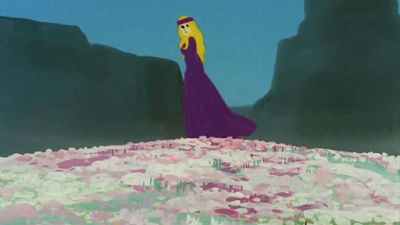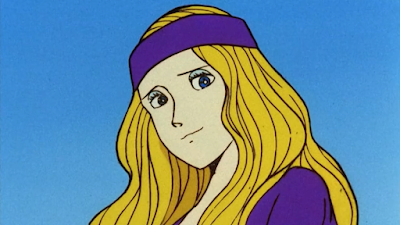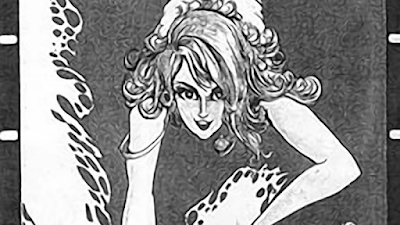Pretty much any long-running anime series has to have at least one episode like this week's. You know the kind: our hero meets a mysterious and tragic girl whose fate is inextricably linked to a thing that must be destroyed. There's probably something vaguely supernatural (or at least weird) about said thing. The girl probably doesn't deserve whatever is going on, but she's almost certainly going to die.
In this spirit, we get Linda the Boomflower Witch. Though what actually makes her a witch... I'm still trying to figure out.
The Story
There's a fair bit of futzing around in this one to start. Lupin and Fujiko are on a motorboat, playfully acting like they're going to kill each other, when they catch up to some actual killers trying to take out a young woman in another boat. The assassins are a notorious gang known as the "Killer-in-Killers," and the woman is a blonde named Linda. Some sharpshooting from a previously-hidden Jigen saves the day, and Fujiko (presumably seeing Lupin is otherwise occupied) takes off with the boat.
No matter, Lupin and Linda are now on an island full of flowers. Flowers Linda smells like. The two have a nice little frolic before meeting up with Dr. Heinlein, a nuclear fission expert running experiments from his lab on the island. Turns out if you pulverize the flowers and mix them with his proprietary blend, you make a powerful explosive. The aforementioned Killers want it very much.
As for Linda? She was Dr. Heinlein's assistant, and he "ran experiments" on her involving the flowers. Now she needs them to survive. Also this "turned her into a witch," though what that actually means is sort of vague.
The battle for the explosive is underway. Fujiko wants it. The Killer-in-Killers want it. Lupin... wants to help Linda. He says as much when captured by the Killers, eventually making his escape.
Dr. Heinlein finally decides the only solution is to burn up all the flowers so no one can use them. Where's Linda when they do this? Frolicking in the flowers, obviously. Dr. Heinlein shoots her as she's burning to death, then gets shot in return by the Killers. His last request to Lupin is to find a missile deep in the ocean, one containing the last portion of his explosive, and deliver it to a lab in Japan.
Lupin nearly manages... but Fujiko shows up, wanting to ride the missile out of the wreckage with him. He explains that any extra weight will prevent them from making it to land, but this doesn't stop her from hitching a ride. We end with Lupin, Jigen, and Fujiko paddling to shore with the remains of the missile.
Witchy Things
This episode is notable for being Lupin's first (and dear God not remotely his last) time rescuing a damsel in distress. His entire motivation is Linda; and once he's gotten the horny out of his system, he actually does respond to her promise to protect her. Granted, he initially assumes she's simply being dramatic, but finding out her claims are true only strengthens his resolve.
Granted, we're dealing with pre-Miyazaki Season 1 Lupin (more on that in a moment), so he's going to have more than a smattering of his manga persona still about him. But this is where, at least in his anime form, we get a first glimpse of his more heroic side.
Then there's the whole thing of Linda herself. The story of the Third Sun flowers, Dr. Heinlein, and Linda herself doesn't come from the manga. The story "Lupin of Arabia" follows Lupin stealing a missile (with the intent of selling it and stealing it again), and is the source of the episode's final scene with Fujiko and a bit of the Killer-in-Killers action.
It's not really sticking my neck out to say this new story is a one off of Nathaniel Hawthorne's short story "Rappaccini's Daughter." Just in case you didn't have to read it in high school: our narrator Giovanni goes away to school in Padua and falls in love with Beatrice, the daughter of medical researcher Giacomo Rappaccini. Raised among the poisonous flowers he researches, she herself also becomes poisonous - and so does Giovanni the more he comes to visit her. He gives her an antidote to the poison, so she can leave her father's garden, but it ends up killing her.
Linda is a pretty clear analog for Beatrice: she's forced to live among the flowers because of an experiment, and eventually dies among them. But that's about it. It's never really explained why Dr. Heinlein claims he turned her into a witch (the word used in Japanese is majo, specifically referring to a magic-using woman, and some releases have translated it as "sorceress").
We do see a final shot of her as she dies, appearing to turn into a flower and waft away on the flames, and Lupin gives a similarly romantic description of her demise. Whether we're meant to see this as some magical happening, or simply an artistic interpretation of her death, it's hard to tell. It's not a terribly well animated episode to start. In fairness, Hawthorne's original work was similarly vague about Beatrice. But it does feel a bit as though there was a scene or story beat cut that might have clarified the "witch" claim.
The Lupin Syndicate
In my first entry of this series, I glossed straight over something pretty big: mention of the Lupin Syndicate. This gets mentioned as a major plot point in Strange Psychokinetic Strategy, the manga, and early episodes of the anime. But we don't hear about it much these days.
So, surprise! Back in the day, Lupin the Third had his own crime syndicate. And I don't just mean Jigen and Goemon and sometimes Fujiko. The manga laid down the idea to some degree that the Lupin family was actually a... you know. Family. That Lupin was feared and revered by the criminal world. And it can be a bit strange to see in retrospect.
It's not hard to see why this has gone almost entirely out the window. Lupin still has associates, old friends, old rivals. In the Blue Jacket series and forward, it's established (at least as far as the TV series go) that "Lupin" is a name passed down along a line of thieves, rather than an actual family line. But even then, he sticks to his trusted small crew.
It's part of his regeneration into the "thief with a heart of gold," it seems. It's a bit hard to argue you're a good guy when you're leading an international crime ring. That aside, we do get to see the great dichotomy of Lupin: the total goofball who can also be pretty terrifying if he cares to be. The guy who, even when his brain seems to be switched off, is potentially still keeping his eyes open. There's a fun little scene in this episode to that effect where Lupin and Fujiko, both seemingly ready to get it on under a tree, are actually squaring up to shoot the half-dozen assassins gathering around them.
I want to close this one out by pointing out something someone else noticed about this episode: it's our first time seeing Lupin actually shed a tear about something. (That "something" being, of course, Linda's demise.) It's an empathy alien to Lupin in the manga, who was all about getting money and things and girls, and whose stories generally ended somewhat humorously. We still have a few episodes left until the game-changers start to arrive on the scene. But even now, he was making a move toward becoming the character we know.
Next week, Zenigata is back!
---
Like what I do? Consider dropping me a tip on Ko-fi — or bookmark the page, since I'll begin offering fresh content over there in the coming weeks!




0 comments:
Post a Comment